

Students Sharing Learning Stories Through Digital Portfolio Curation. What is the relationship between school and learning?
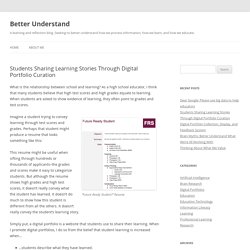
As a high school educator, I think that many students believe that high test scores and high grades equate to learning. When students are asked to show evidence of learning, they often point to grades and test scores. “Future Ready Student?” Resume Imagine a student trying to convey learning through test scores and grades. This resume might be useful when sifting through hundreds or thousands of applicants–the grades and scores make it easy to categorize students. Simply put, a digital portfolio is a website that students use to share their learning.
…students describe what they have learned. A digital portfolio is a student’s personal learning story. Let’s say that you’re part of a school that has decided to give digital portfolios a try. At the 2017 SDCUE Tech Fair, I shared a digital portfolio collection and display system that I invite any school leader to copy/modify. School-wide: Classroom level: How ePortfolios Can Prepare K-12 Students for College, and Beyond. With the Common Core State Standards emphasis on 21st century skills, as well as the expectation that today’s workers are technically savvy when they enter the workforce, career and college readiness in the K-12 classroom is more important than ever.
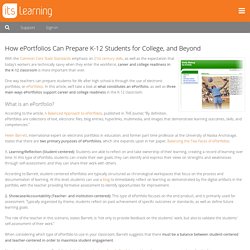
One way teachers can prepare students for life after high school is through the use of electronic portfolios, or ePortfolios. In this article, we’ll take a look at what constitutes an ePortfolio, as well as three main ways ePortfolios support career and college readiness in the K-12 classroom. What is an ePortfolio? According to the article, A Balanced Approach to ePortfolios, published in THE Journal, “By definition, ePortfolios are collections of text, electronic files, blog entries, hyperlinks, multimedia, and images that demonstrate learning outcomes, skills, and competencies.” 1.
Types of Portfolios. Page 1 of 2 A portfolio in the context of the classroom is a collection of student work that evidences mastery of a set of skills, applied knowledge, and attitudes.
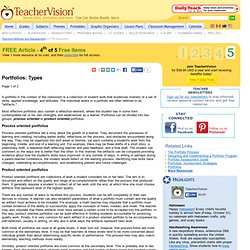
The individual works in a portfolio are often referred to as "artifacts. " Most effective portfolios also contain a reflective element, where the student has in some form contemplated her or his own strengths and weaknesses as a learner. Portfolios can be divided into two groups: process oriented or product oriented portfolios. Process oriented portfolios. The 3 Types of Digital Portfolios Teachers should Know about. Portfolios: More than a file folder. Digital Portfolios and Blogs: Use Authentic Technology, Not Technology Made for School. Portfolios hold new promise for schools. The 3,000 students in rural Maine’s Regional School Unit 19 begin compiling electronic portfolios of their schoolwork in pre-K, when the district issues every child a Google account.
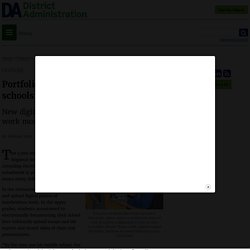
In the elementary years, teachers snap and upload digital photos of handwritten work. In the upper grades, students accustomed to electronically documenting their school lives habitually upload essays and lab reports and record video of their oral presentations. “By the time you hit middle school, the students are just doing it because that’s the way we do business,” says Kern Kelley, the Maine district’s technology integrator. Decades ago, portfolio assessment—using samples of classroom work to document students’ progress toward learning goals—meant finding room for bulging binders stuffed with paper. But digital technologies that make it far easier to collect, curate, share and store student work have dismantled the physical barriers that once made portfolio assessment daunting.
Electronic Portfolios a Decade into the Twenty-first Century: What We Know, What We Need to Know. During the last decade, campuses designing electronic portfolios have used them both in curricular and assessment contexts.
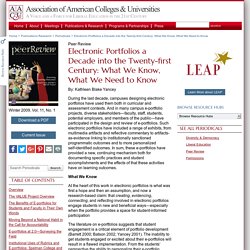
Student Portfolios: the Narrative of Learning. One of the seven elements of personalized learning we describe in our book Students at the Center: Personalized Learning With Habits of Mind is a Cumulative Demonstration of Learning.
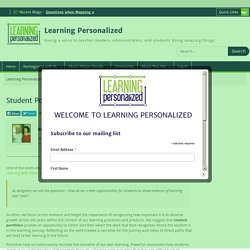
As designers, we ask the question–– how do we create opportunities for students to show evidence of learning over time? So often, we focus on the moment and forget the importance of recognizing how important it is to observe growth across the years within the content of our learning processes and products. We suggest that student portfolios provide an opportunity to collect and then select the work that best recognizes where the student is in the learning journey. Reflecting on the work creates a narrative for the journey and helps to direct paths that will lead to her learning in the future. Portfolios help us continuously recreate the narrative of our own learning. Digital Student Portfolios Show What Kids Can Do.
By Matt Renwick When our students leave our schools, what can they point to and say, “I did that”?

The typical artifacts of education they might choose include sports trophies, a diploma, and the cap and gown. But what does any of this tell us about their educational experience? Very little, especially about the main reason for school: learning. It doesn’t have to be this way. Enter digital student portfolios. For example, knowing a student’s current reading level pales in comparison to hearing them read a text and then reading their reflection on how they feel they performed in this assessment. So what happens when students start to own their learning and teachers realize that traditional methods of assessment are no longer cutting it?
Genius Hour Connections This concept involves devoting part of the school day to allow students to explore topics they want to learn more about. In a sea of standards, this can be hard shift for teachers. Toward Gradeless Classrooms © Matt Renwick. How Do Digital Portfolios Help Students? About ETR Community EdTechReview (ETR) is a community of and for everyone involved in education technology to connect and collaborate both online and offline to discover, learn, utilize and share about the best ways technology can improve learning, teaching, and leading in the 21st century.
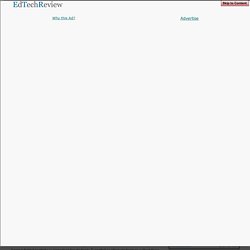
EdTechReview spreads awareness on education technology and its role in 21st century education through best research and practices of using technology in education, and by facilitating events, training, professional development, and consultation in its adoption and implementation.